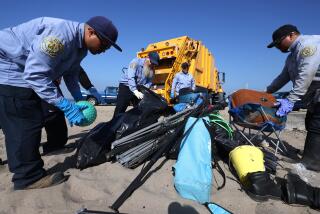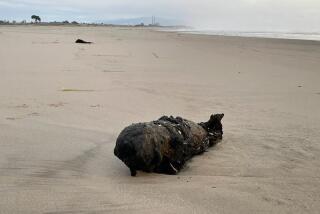Taiwan aiming to turn fortified beach into resort
KINMEN, TAIWAN — They crowd the beaches of this Taiwanese island just two miles from the Chinese coast: tens of thousands of anti-personnel land mines meant to deter an invasion from rival China.
The mines were first planted in the 1950s when this tiny beachhead, also known as Quemoy, was subjected to frequent Chinese shelling, and war was a constant threat.
The two sides split amid civil war in 1949, and, in a famous battle that October, the Nationalist army of Chiang Kai-shek stopped Mao Tse-tung’s communists at Kinmen’s maritime doorstep.
China and Taiwan are still at loggerheads -- Beijing threatens to attack if Taiwan formalizes its de facto independence -- but here, amid the rolling hills and green millet fields, the conflict seems like a distant memory.
For the last seven years, Kinmen and a scattering of villages across the water in China’s Fujian province have enjoyed direct trade and transportation links, boosting commerce between them and drawing their peoples together.
Now the Taiwanese military has taken things one step further, embarking on a six-year program to clear the estimated 70,000 mines concentrated in 153 fields around the island’s perimeter.
The goal is to turn this former battlefield into a tourist resort, exploiting more than eight miles of pristine beaches to attract visitors from far and wide.
Supervising the effort is Taiwanese army Col. Ku Chien-chin, a no-nonsense engineer with a ramrod posture and a piercing stentorian voice.
“We now have 66 army engineers working on the project,” Ku said. “Our main purpose is to open Kinmen for tourism, to make the environment safer.”
It’s a tall order. Besides the mines, dozens of unexploded mortar shells and other types of ordnance litter the island’s 58 square miles, offering potential tourists the kind of challenge they don’t normally encounter in conventional beach resorts.
But Kinmen’s historical cachet and its natural beauty are formidable tourist draws. Spread amid the pines and acacia trees are clear reminders of past struggles -- abandoned bunkers perched on rocky outcroppings, protective tunnels dug into steeply rising hills, and concrete staves designed to ward off invading paratroopers.
Perhaps the strangest of all is the exhortatory message posted in Chiang’s neat calligraphy on a huge rock near the center of the island.
“Forget not you’re in Ju,” it says, informing the faithful in an instantly recognizable historical allusion that despite the communist victory in 1949, the mainland can still be retaken by Nationalist forces.
More to Read
Sign up for Essential California
The most important California stories and recommendations in your inbox every morning.
You may occasionally receive promotional content from the Los Angeles Times.









